Long-duration M2.4 solar flare erupts, Earth-directed CME
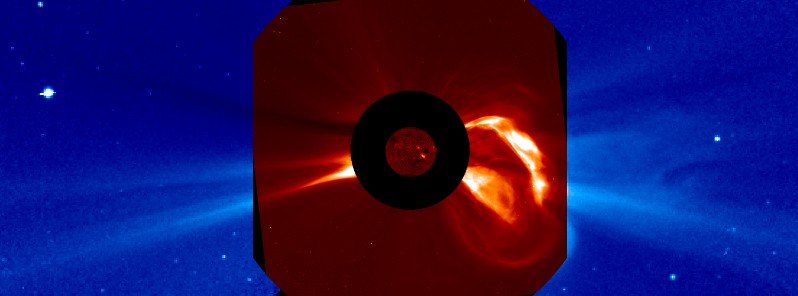
Active Region 2665 produced a long-duration solar flare measuring M2.4 at its peak time on July 14, 2017. The event lasted for more than 2 hours; it started at 01:07, peaked at 02:09 and ended at 03:24 UTC. The eruption produced a coronal mass ejection (CME) with an Earth-directed component. This region is now moving away from the center of the Earth-facing Sun but could still produce moderate to strong eruptions in the days ahead.
The eruption was associated with a Type IV radio emission. Type IV emissions occur in association with major eruptions on the Sun and are typically associated with strong coronal mass ejections and solar radiation storms.
This CME is expected to reach Earth late Sunday, July 16 or early Monday, July 17.
Additionally, a 10cm Radio Burst lasting 44 minutes with peak flux of 130 sfu was associated with the event. A 10cm radio burst indicates that the electromagnetic burst associated with a solar flare at the 10cm wavelength was double or greater than the initial 10cm radio background. This can be indicative of significant radio noise in association with a solar flare. This noise is generally short-lived but can cause interference for sensitive receivers including radar, GPS, and satellite communications.
The greater than 10 MeV proton flux at geosynchronous orbit exceeded the S1 – Minor solar radiation storm threshold at 09:00 UTC.
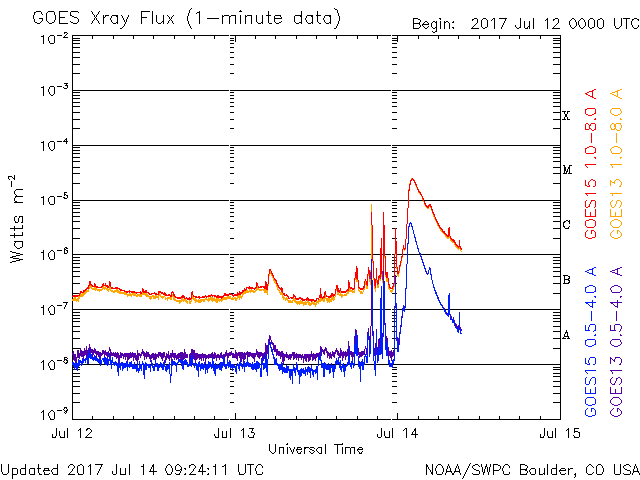
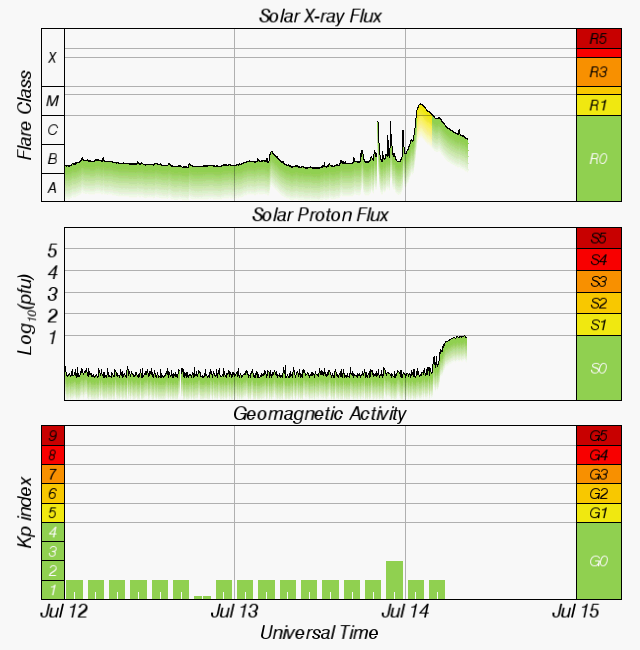
WSA Enlil model below shows a potential glancing blow from a CME observed off the west limb at approximately 13:00 UTC on July 13. The impact is expected midday July 17, and could possibly combine with today's CME.
The model below shows CME impact expected on July 16:
Region 2665 (beta) is now moving away from the center of the Earth-facing Sun, but is still potent enough to produce moderate to strong eruptions in the days ahead.
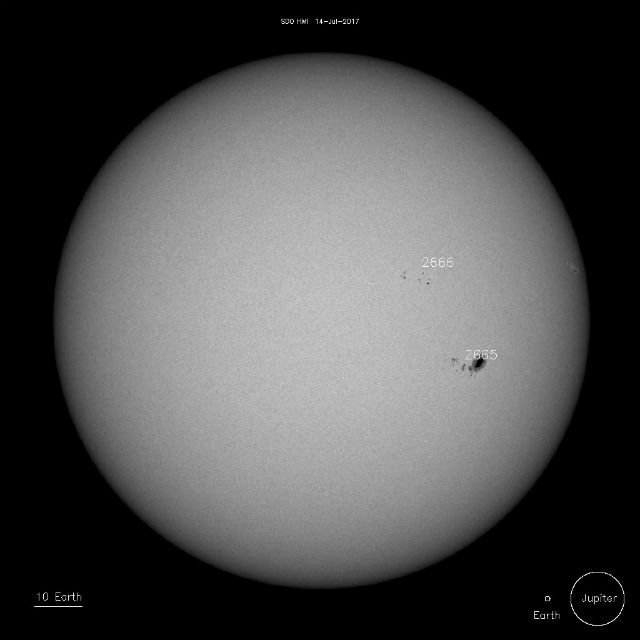

Sunspots on July 14, 2017. Credit: NASA SDO/HMI
A watch has been issued for likely G2 – Moderate geomagnetic storm conditions on July 16 and 17.
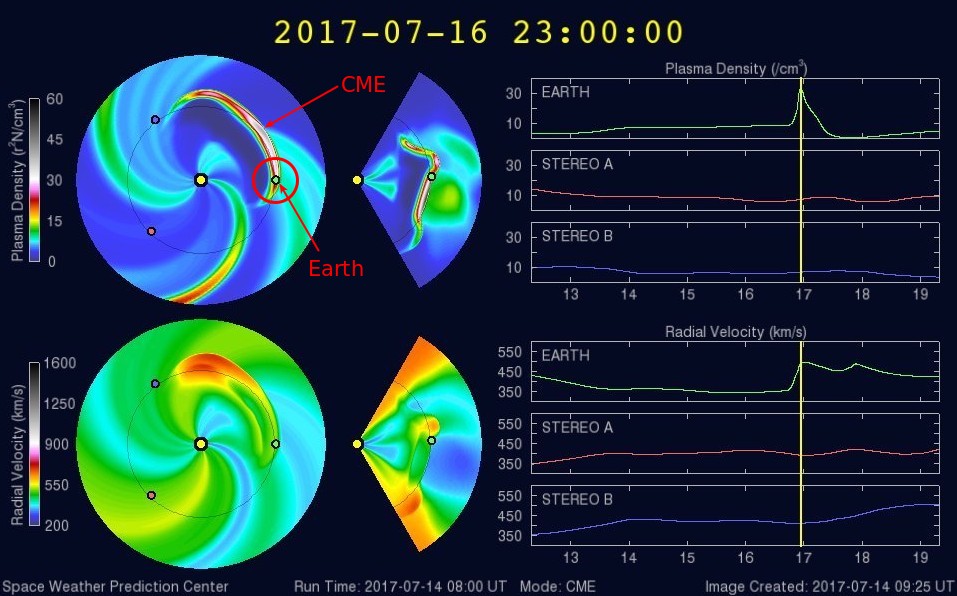

SWPC Alerts
Space Weather Message Code: WARPX1
Serial Number: 460
Issue Time: 2017 Jul 14 1755 UTC
EXTENDED WARNING: Proton 10MeV Integral Flux above 10pfu expected
Extension to Serial Number: 459
Valid From: 2017 Jul 14 0530 UTC
Now Valid Until: 2017 Jul 15 1200 UTC
Warning Condition: Persistence
Predicted NOAA Scale: S1 – Minor
Potential Impacts: Radio – Minor impacts on polar HF (high frequency) radio propagation resulting in fades at lower frequencies.
***
Space Weather Message Code: WATA30
Serial Number: 161
Issue Time: 2017 Jul 14 1029 UTC
WATCH: Geomagnetic Storm Category G2 Predicted
Highest Storm Level Predicted by Day:
Jul 15: None (Below G1) Jul 16: G2 (Moderate) Jul 17: G2 (Moderate)
THIS SUPERSEDES ANY/ALL PRIOR WATCHES IN EFFECT
Potential Impacts: Area of impact primarily poleward of 55 degrees Geomagnetic Latitude.
Induced Currents – Power grid fluctuations can occur. High-latitude power systems may experience voltage alarms.
Spacecraft – Satellite orientation irregularities may occur; increased drag on low Earth-orbit satellites is possible.
Radio – HF (high frequency) radio propagation can fade at higher latitudes.
Aurora – Aurora may be seen as low as New York to Wisconsin to Washington state.
***
Space Weather Message Code: ALTPX1
Serial Number: 315
Issue Time: 2017 Jul 14 0919 UTC
ALERT: Proton Event 10MeV Integral Flux exceeded 10pfu
Begin Time: 2017 Jul 14 0900 UTC
NOAA Scale: S1 – Minor
Potential Impacts: Radio – Minor impacts on polar HF (high frequency) radio propagation resulting in fades at lower frequencies.
***
Space Weather Message Code: WARPX1
Serial Number: 459
Issue Time: 2017 Jul 14 0530 UTC
WARNING: Proton 10MeV Integral Flux above 10pfu expected
Valid From: 2017 Jul 14 0530 UTC
Valid To: 2017 Jul14 1800 UTC
Warning Condition: Onset
Predicted NOAA Scale: S1 – Minor
Potential Impacts: Radio – Minor impacts on polar HF (high frequency) radio propagation resulting in fades at lower frequencies.
***
Space Weather Message Code: ALTTP4
Serial Number: 536
Issue Time: 2017 Jul 14 0235 UTC
ALERT: Type IV Radio Emission
Begin Time: 2017 Jul 14 0202 UTC
Description: Type IV emissions occur in association with major eruptions on the sun and are typically associated with strong coronal mass ejections and solar radiation storms.
***
Space Weather Message Code: SUM10R
Serial Number: 692
Issue Time: 2017 Jul 14 0231 UTC
SUMMARY: 10cm Radio Burst
Begin Time: 2017 Jul 14 0110 UTC
Maximum Time: 2017 Jul 14 0151 UTC
End Time: 2017 Jul 14 0154 UTC
Duration: 44 minutes
Peak Flux: 130sfu
Latest Penticton Noon Flux: 92 sfu
Description: A 10cm radio burst indicates that the electromagnetic burst associated with a solar flare at the 10cm wavelength was double or greater than the initial 10cm radio background. This can be indicative of significant radio noise in association with a solar flare. This noise is generally short-lived but can cause interference for sensitive receivers including radar, GPS, and satellite communications.
Featured image: CME produced by M2.4 solar flare on July 14, 2017. Credits: NASA, ESA, SOHO, SDO

Watch for major earthquake or volcanic eruption in the coming 2-3 days